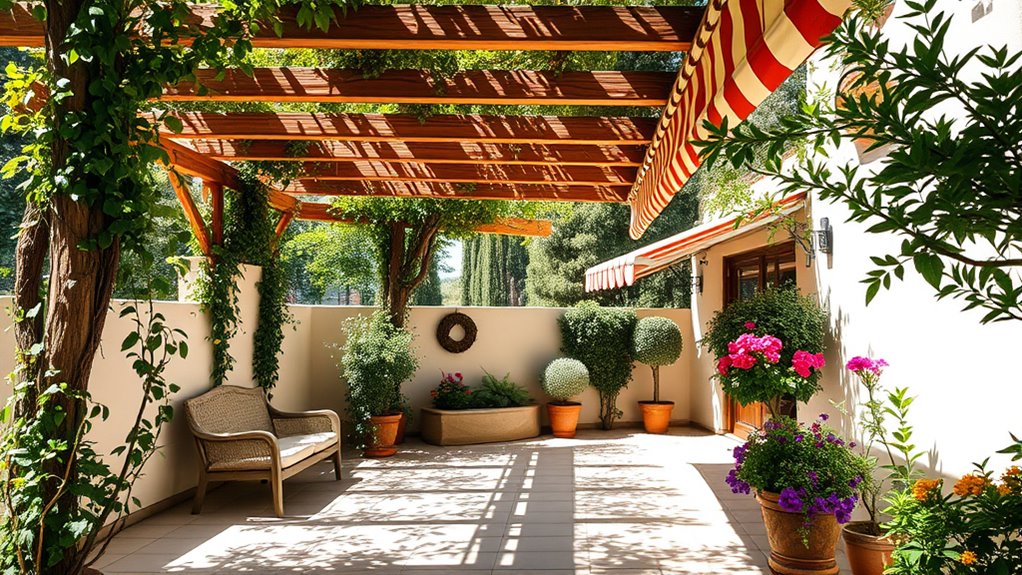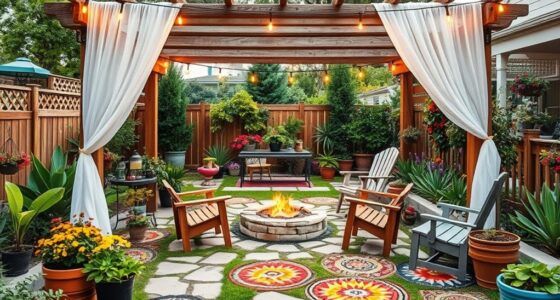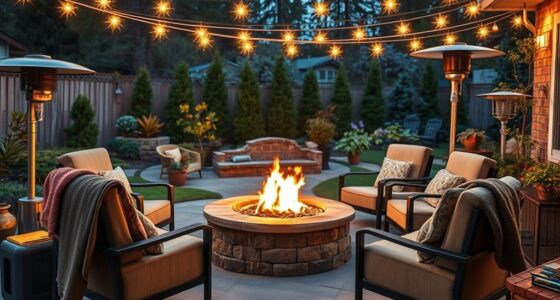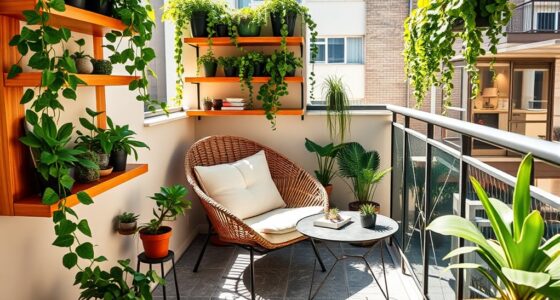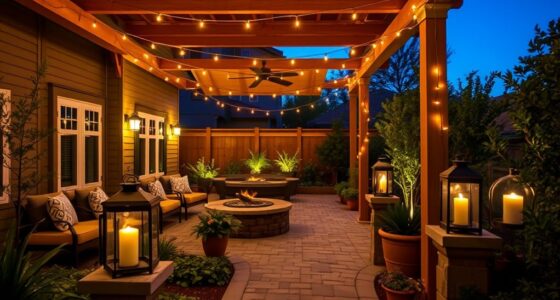To create effective shade, you can combine pergolas, awnings, and plants for a versatile outdoor solution. Pergolas with climbing plants like jasmine or grapes offer natural, adjustable shade that grows more lush over time. Awnings provide instant, retractable coverage to block sun during peak hours, while trees and shrubs add layered, organic shade and privacy. Together, these elements boost comfort and style, helping you achieve a cool, inviting outdoor space. Keep exploring to discover how these options work best for your needs.
Key Takeaways
- Pergolas with climbing plants provide natural, customizable shade by blocking sunlight and allowing light when desired.
- Retractable awnings offer instant, adjustable shade to enhance outdoor comfort and protect against UV rays.
- Combining trees, shrubs, and vines creates layered, organic shade solutions that improve solar protection and privacy.
- Materials like wood, metal, or vinyl pergolas can be tailored to style and budget, accommodating various outdoor aesthetics.
- Integrating plants with structures maximizes solar protection while adding beauty and a tranquil atmosphere to outdoor spaces.
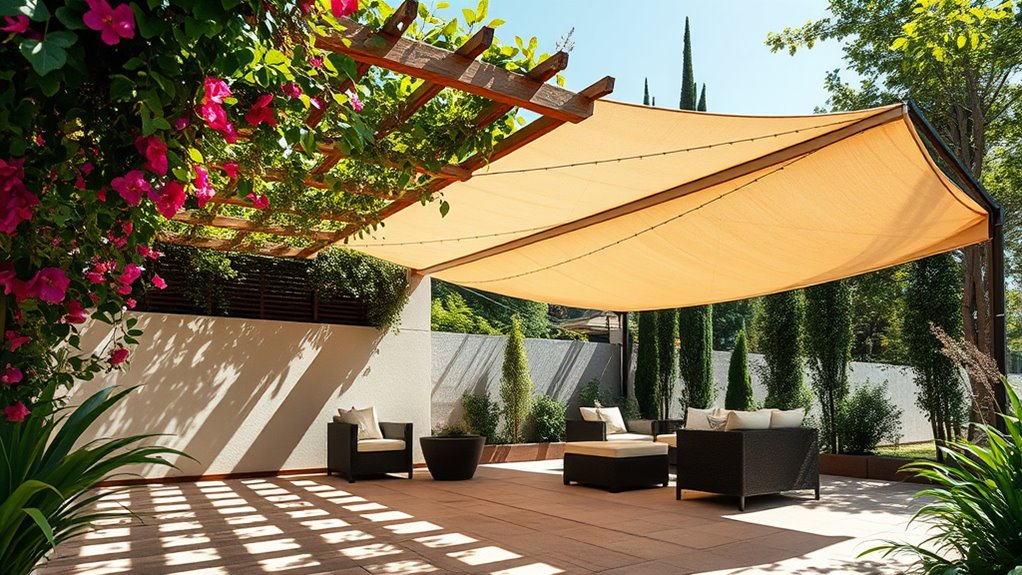
Have you ever wondered how to effectively create shade in your outdoor space? Achieving the right shade not only adds a touch of style but also enhances solar protection and outdoor comfort. When you take the time to plan and choose the right elements, you can enjoy your outdoor area even during the hottest parts of the day. Pergolas, awnings, and plants each offer unique benefits and can work together to transform your space into a cool, inviting retreat.
Pergolas are a classic choice for creating shaded areas, especially if you want to add structure and visual interest. They’re versatile and can be made from wood, metal, or vinyl, depending on your style and budget. You can leave the beams open or add climbing plants like wisteria, grapes, or jasmine to provide natural shade and a lush, organic feel. As these plants grow, they not only block sunlight but also improve solar protection, making your outdoor space more comfortable. Plus, pergolas allow you to enjoy the sunlight when you want it, making them perfect for balancing sun and shade throughout the day.
Pergolas with climbing plants offer stylish, natural shade and flexible sunlight enjoyment.
Awnings are another effective way to provide instant shade and enhance outdoor comfort. They come in various styles, from retractable fabric designs to fixed structures. Retractable awnings give you the flexibility to control how much shade you want at any given time, which is especially useful when weather conditions change. When extended, they shield you from direct sunlight, reducing heat and glare, and protecting your skin from UV rays. Their fabric can also help block out harmful solar radiation, improving overall solar protection. With an awning in place, you can set up outdoor dining or lounging areas that stay cool and comfortable, even during peak sun hours.
Plants are a natural, eco-friendly option that adds beauty while providing shade. Tall trees, dense shrubs, or fast-growing vines can create a canopy that filters sunlight and cools the air. Consider planting deciduous trees that shed their leaves in winter, so you get shade in summer without blocking sunlight in colder months. Using plants in strategic locations can offer privacy and shield your outdoor space from wind and noise as well. They also contribute to a sense of tranquility, making your yard more inviting. Combining plants with man-made structures like pergolas or awnings creates a layered shading effect, maximizing solar protection and elevating outdoor comfort.
Frequently Asked Questions
What Are the Best Materials for Long-Lasting Pergolas?
You should choose materials like cedar, redwood, or vinyl for long-lasting pergolas, as they offer excellent material durability and resist rot and pests. Aluminum is also a great option because it’s lightweight, low-maintenance, and highly durable. These materials provide design versatility, allowing you to customize your pergola’s style and size. Investing in quality materials guarantees your pergola remains beautiful and functional for years to come.
How Do I Maintain and Clean Outdoor Fabric Awnings?
You might think outdoor fabric awnings are tough to maintain, but regular fabric cleaning keeps them in top shape. To do this, gently wash the awning with mild soap and water, avoiding harsh chemicals. For awning maintenance, always retract the awning during storms to prevent damage and check for tears or mold. A quick rinse every few months helps remove dirt and prolongs its lifespan, ensuring your shade stays fresh and functional.
Which Plants Provide Natural Shade and Require Minimal Care?
You can grow native species like oak or maple to provide natural shade with minimal care, as they’re adapted to your climate. Drought-tolerant plants such as succulents or lavender also offer shade and require less watering and maintenance. These plants thrive with less attention, helping you enjoy a shaded outdoor space while conserving water and effort. Choose native or drought-tolerant options to keep your landscape sustainable and low-maintenance.
Can I Install a Shade Structure Myself or Should I Hire a Professional?
You can definitely tackle a DIY installation if you’re handy and confident, but it’s no small feat—this task can be as complex as solving a puzzle with a million pieces. For best results and safety, consider professional assistance, especially for sturdy, long-lasting shade structures. Hiring experts guarantees proper setup, saves you time, and avoids costly mistakes, making your shaded oasis perfect and worry-free.
What Are the Cost Differences Between Various Shading Options?
You’ll find that the cost comparison between shading options varies widely. DIY pergolas or awnings tend to be more budget-friendly, often costing a few hundred dollars, while professional installations can range from $1,000 to several thousand. To plan your budget effectively, consider both material costs and installation fees. Knowing these differences helps you make informed choices, ensuring your shade solution fits your needs and financial plan.
Conclusion
By combining pergolas, awnings, and lush plants, you craft a sanctuary where shade becomes a welcoming embrace rather than a mere shelter. Think of your outdoor space as a living mosaic, each element adding depth and personality. With a little planning and creativity, you’ll transform your yard into a cool oasis—a gust of fresh inspiration in the summer heat, where comfort and beauty grow side by side, like a well-tended garden of serenity.
